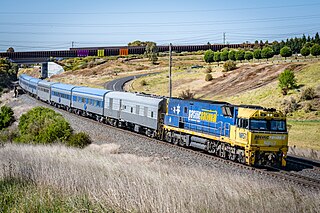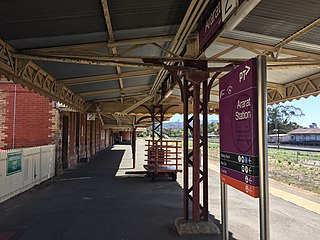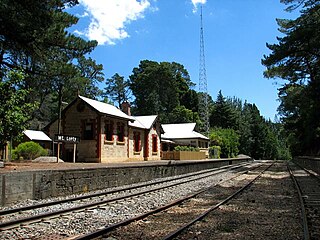
The rail network in Adelaide, South Australia, consists of four lines and 89 stations, totalling 132 km (82 mi). It is operated by Keolis Downer under contract from the Government of South Australia, and is part of the citywide Adelaide Metro public transport system.

Murray Bridge is a city in the Australian state of South Australia, located 78 kilometres (48 mi) east-southeast of the state's capital city, Adelaide, and 77 kilometres (48 mi) north of the town of Meningie.

The Overland is an interstate passenger train service in Australia, travelling between the state capitals of Melbourne and Adelaide, a distance of 828 km (515 mi). It first ran in 1887 as the Adelaide Express, known by South Australians as the Melbourne Express. It was given its current name in 1936. Now operated by private company Journey Beyond, the train undertakes two return trips a week. Originally an overnight train that stopped at large intermediate stations, it now operates during the day, stopping less frequently.

The first railway in colonial South Australia was a line from the port of Goolwa on the River Murray to an ocean harbour at Port Elliot, which first operated in December 1853, before its completion in May 1854.

Adelaide Parklands Terminal, formerly known as Keswick Terminal, is the interstate passenger railway station in Adelaide, South Australia. It is the only station in the world where passengers can board trains on both north–south and east–west transcontinental routes.

The Gawler line, also known as the Gawler Central line, is a suburban commuter railway line in the city of Adelaide, South Australia. The Gawler Line is the most frequent and heavily patronised line in the Adelaide rail network.

The Belair line is a suburban rail commuter route in the city of Adelaide, South Australia, that runs from the Adelaide station to Belair in the Adelaide Hills via the Adelaide-Wolseley line using diesel 3000/3100 class railcars. Prior to 1995, this part of Adelaide-Wolseley was a two-track broad gauge line. In 1995, Adelaide-Wolseley was converted to standard gauge meaning Adelaide to Belair is now effectively two separate single-track lines running in parallel: the Belair commuter line and the Adelaide-Wolseley standard gauge freight line.
The Serviceton railway line is part of the Melbourne–Adelaide rail corridor. It serves the west of Victoria, linking the state capital of Melbourne to the cities of Ballarat and Ararat. It once extended to the disputed South Australian border as part of the Melbourne–Adelaide railway. The former broad-gauge track was replaced in 1995 by the 1435 mm Western standard gauge line.

Ararat railway station is located on the Serviceton and Western standard gauge lines in Victoria, Australia. It serves the town of Ararat, and opened on 7 April 1875.

The Bridgewater railway line is a former passenger railway service on the Adelaide to Wolseley line in the Adelaide Hills. It was served by suburban services from Adelaide. On 26 July 1987, the service was curtailed to Belair and renamed Belair railway line. In 1995, the Adelaide-Wolseley line was converted to standard gauge as part of the One Nation infrastructure program, disconnecting the abandoned Bridgewater line stations from the broad gauge suburban railway system.

The Melbourne–Adelaide rail corridor consists of the 828-kilometre (514-mile) long 1435 mm standard-gauge main line between the Australian state capitals of Melbourne, Victoria and Adelaide, South Australia, and the lines immediately connected to it. Most of its traffic is freight; the only passenger train along the entire route is the twice-weekly passenger service The Overland, operated by Journey Beyond.
The Adelaide–Wolseley railway line is a 313 kilometre line running from Adelaide to Wolseley on the Australian Rail Track Corporation network. It is the South Australian section of the Melbourne–Adelaide railway.

Bordertown railway station is located on the Adelaide to Wolseley line in Bordertown.

Tailem Bend railway station is located on the Adelaide-Wolseley line in Tailem Bend, South Australia. It is also the junction point for the Loxton and Pinnaroo lines.
Petwood railway station was a ground-level stopping place located on the Adelaide to Wolseley line serving the South Australian locality of Petwood.

Coomandook railway station was located in the town of Coomandook, about 153 kilometres from Adelaide station.

Coonalpyn railway station is located on the Adelaide-Wolseley line in Coonalpyn, South Australia.

Culburra railway station was located on the Adelaide-Wolseley line in Culburra, South Australia.
Tintinara railway station is located on the Adelaide-Wolseley line in Tintinara, South Australia.
Coombe railway station was located on the Adelaide-Wolseley line in Coombe, South Australia.















